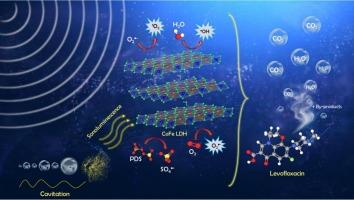Ultrasound-assisted heterogeneous activation of peroxydisulfate by cobalt‑iron layered double hydroxide for efficient pharmaceutics degradation
IF 5.8
2区 地球科学
Q2 CHEMISTRY, PHYSICAL
引用次数: 0
Abstract
In this study, CoFe layered double hydroxide (LDH) was synthesized using the co-precipitation method, and the successful synthesis of it was confirmed by the X-ray diffraction pattern. The surface functional group of LDH was assessed by Fourier-transform infrared spectroscopy, and its elemental composition was analyzed using energy-dispersive X-ray spectroscopy and X-ray photoelectron spectroscopy. Scanning and transmission electron microscopy analyses verified the layered structure of the LDH. The catalytic activity of CoFe LDH, with a band gap of 2.42 eV, was investigated for the activation of peroxydisulfate (PDS) under ultrasonic irradiation (US) for the degradation of levofloxacin. The effect of operational parameters, including pH, pollutant concentration, catalyst dosage, and PDS concentration, was investigated. The highest degradation efficiency of 97.1 % was obtained for levofloxacin with an initial concentration of 15 mg/L under optimized conditions of 0.4 mmol/L of PDS, 0.5 g/L of CoFe LDH, and pH 6 within 120 min of reaction. The prominent roles of reactive radical and non-radical species, including sulfate radicals, hydroxyl, singlet oxygen, and generated holes, were revealed by employing various scavengers, indicating that the singlet oxygen played the most significant role in this system. The degradation intermediates were identified using gas chromatography–mass spectrometry, and a probable mechanism was proposed for the levofloxacin degradation. Finally, the developed ternary CoFe LDH/PDS/US system was successfully used to treat three other diverse pharmaceuticals, including tilmicosin, oxytetracycline, and cefixime, achieving 100 % degradation efficiency and highlighting the potential of this process in water treatment applications.

超声辅助下钴-铁层状双氢氧化物对过硫酸氢氧化物的非均相活化,用于有效的药物降解
本研究采用共沉淀法合成了CoFe层状双氢氧化物(LDH),并通过x射线衍射图证实了其合成的成功。采用傅里叶变换红外光谱对LDH表面官能团进行了表征,并用能量色散x射线能谱和x射线光电子能谱对其元素组成进行了分析。扫描电镜和透射电镜分析证实了LDH的层状结构。研究了带隙为2.42 eV的CoFe LDH在超声照射下活化过硫酸氢盐(PDS)降解左氧氟沙星的催化活性。考察了pH、污染物浓度、催化剂用量、PDS浓度等操作参数对反应的影响。在PDS浓度为0.4 mmol/L、CoFe LDH浓度为0.5 g/L、pH为6的条件下,反应时间为120 min,初始浓度为15 mg/L的左氧氟沙星降解率最高,为97.1%。通过各种清除剂的研究,发现硫酸盐自由基、羟基、单线态氧和生成的空穴等活性自由基和非自由基在该体系中发挥着突出的作用,表明单线态氧在该体系中起着最重要的作用。采用气相色谱-质谱联用技术对降解中间体进行了鉴定,并对左氧氟沙星的降解机理进行了初步探讨。最后,开发的三元CoFe LDH/PDS/US系统成功地用于处理其他三种不同的药物,包括替米科星、土霉素和头孢克肟,达到100%的降解效率,突出了该工艺在水处理中的应用潜力。
本文章由计算机程序翻译,如有差异,请以英文原文为准。
求助全文
约1分钟内获得全文
求助全文
来源期刊

Applied Clay Science
地学-矿物学
CiteScore
10.30
自引率
10.70%
发文量
289
审稿时长
39 days
期刊介绍:
Applied Clay Science aims to be an international journal attracting high quality scientific papers on clays and clay minerals, including research papers, reviews, and technical notes. The journal covers typical subjects of Fundamental and Applied Clay Science such as:
• Synthesis and purification
• Structural, crystallographic and mineralogical properties of clays and clay minerals
• Thermal properties of clays and clay minerals
• Physico-chemical properties including i) surface and interface properties; ii) thermodynamic properties; iii) mechanical properties
• Interaction with water, with polar and apolar molecules
• Colloidal properties and rheology
• Adsorption, Intercalation, Ionic exchange
• Genesis and deposits of clay minerals
• Geology and geochemistry of clays
• Modification of clays and clay minerals properties by thermal and physical treatments
• Modification by chemical treatments with organic and inorganic molecules(organoclays, pillared clays)
• Modification by biological microorganisms. etc...
 求助内容:
求助内容: 应助结果提醒方式:
应助结果提醒方式:


